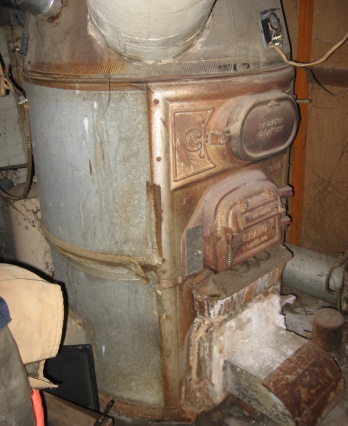 In 1960, the Junior High Boys’ Sunday School class met in the furnace room. I’m pretty sure code wouldn’t allow that today. Our so-called classroom was located smack dab in the center of the low-ceilinged basement in a century old, wood-sided building. It was lit by a single 75-watt incandescent bulb hung from its wire over a wooden table, dropping a circle of yellow light that bounced off the onto the unpainted concrete walls.
In 1960, the Junior High Boys’ Sunday School class met in the furnace room. I’m pretty sure code wouldn’t allow that today. Our so-called classroom was located smack dab in the center of the low-ceilinged basement in a century old, wood-sided building. It was lit by a single 75-watt incandescent bulb hung from its wire over a wooden table, dropping a circle of yellow light that bounced off the onto the unpainted concrete walls.
The walls were like cryptic tombs graffitied with the names of former Sunday School legends, including our teacher and my future father-in-law, Wayne. Other than the graffiti, there were no wall decorations save last year’s calendar now exhausted at December and reminding us “Jesus Is the Reason for the Season.”
The room was so small, one corner of the table had to be forced against the antique gas furnace. Whenever the thermostat in the sanctuary hollered down for more heat, the furnace wheezed and shuttered and then—with a rush of gaseous air—ignited with a muffled “Boof!” It reminded me of Tippy, our timid Springer Spaniel, who barked under her breath when she was frightened, and the loose skin on the sides of her snout billowed out like tiny air mattresses—“Boof! Boof!”
The claustrophobic space allowed for only six or seven high energy boys and one prayed-up adult. Folding wooden chairs encircled the table, with faded stenciling across their backs that ironically read, “Thomas’ Funeral Home – Quiet Care.” Junior High Boys don’t actually sit in wooden folding chairs; instead, they ride them like a bucking horse tipping back on its hind legs, hooking one toe under the table skirt for balance. This posture placed you in just the right position to flick your neighbor’s ear—which usually resulted in a leg sweep by the ear-rubbing recipient that collapsed the offender to the floor in a heap. Guffaws all around! This was well before seat belts or bike helmets, which may account for a number of brain damaged men my age.
Sunday School at Oakthorpe Christian Union Church was where I memorized the books of the Bible. The learning devise was simple competition, and no one loves competition more than pubescent boys. The first boy would shout out “Genesis!”, the next boy “Exodus!” and the race was on! We would see how fast we could keep the circle moving through all 66 books. Like musical chairs, you had to drop out if you answered incorrectly or even hesitated.
In that competitive environment it took only a few weeks to learn what has become one of the most important volumes of information I’ve ever committed to memory. Decades later, I can still recite all the books of the Old and New Testament in order. (There is one small problem—like the alphabet song, I must start at the beginning and say them so fast I usually streak right past the book for which I’m searching. As I’ve aged, it’s become necessary to take a breath somewhere around the Minor Prophets.) This simple yet effective game provided me an incredible gift and instilled in me a lifelong respect for the Scriptures.
Once Jesus was asked what was the most important thing in the whole entire Bible. Well, here, I’ll just let you read what happened. It’s found in Zephaniah-Haggai-Zechariah-Malachi-Matthew, the first book of the New Testament:
“And one of them, a lawyer, asked him a question to test him. ‘Teacher, which is the great commandment in the Law?’ And he said to him, ‘You shall love the Lord your God with all your heart and with all your soul and with all your mind. This is the great and first commandment. And a second is like it: You shall love your neighbor as yourself. On these two commandments depend all the Law and the Prophets.’”
Matthew 22:35-40
In today’s way-too-complex-world, I hope I can remember Jesus’ uncomplicated assignment: “Ron, I want you to care about My Father and other people at least as much as you care about yourself.” Sixty-six books are summed up in those two simple commands. It lacks the competitive element, but I’m gonna work on it. I hope you will too.
Read Ron’s column, Simple Faith, each Saturday on the Faith Page (page 3) of the Lancaster Eagle Gazette, or visit www.lancastereaglegazette.com.
